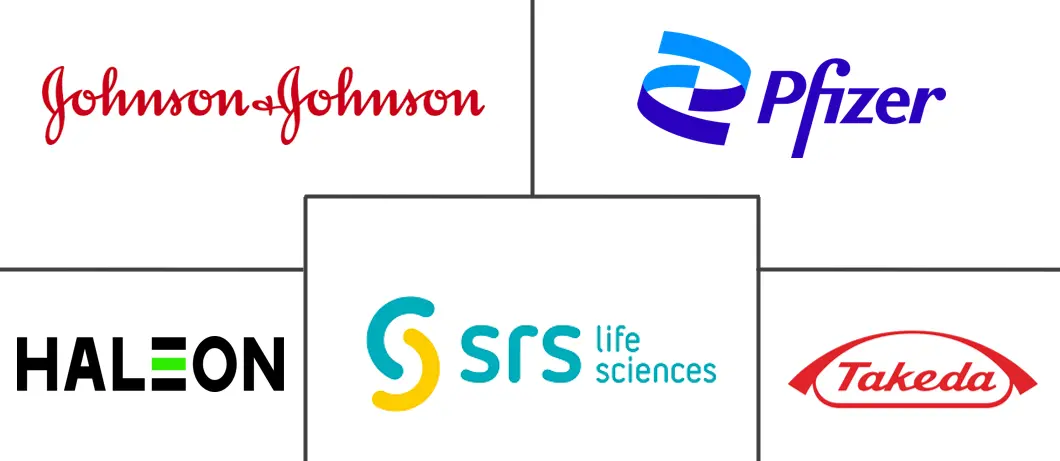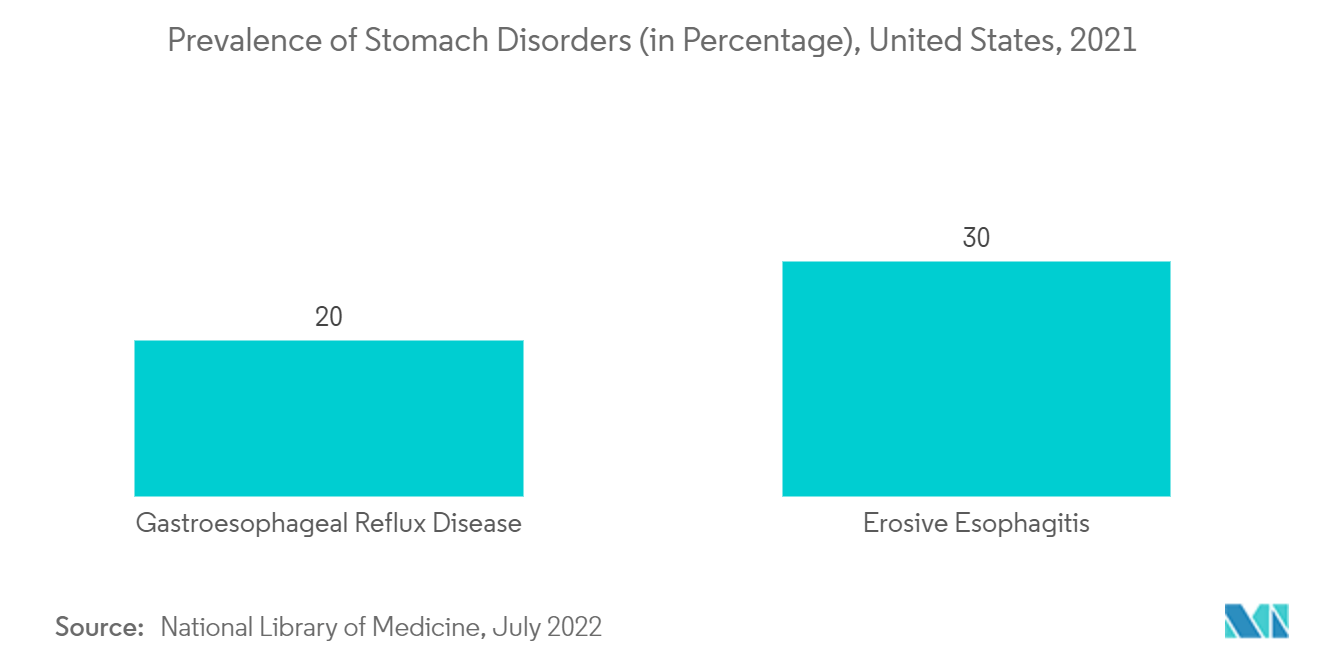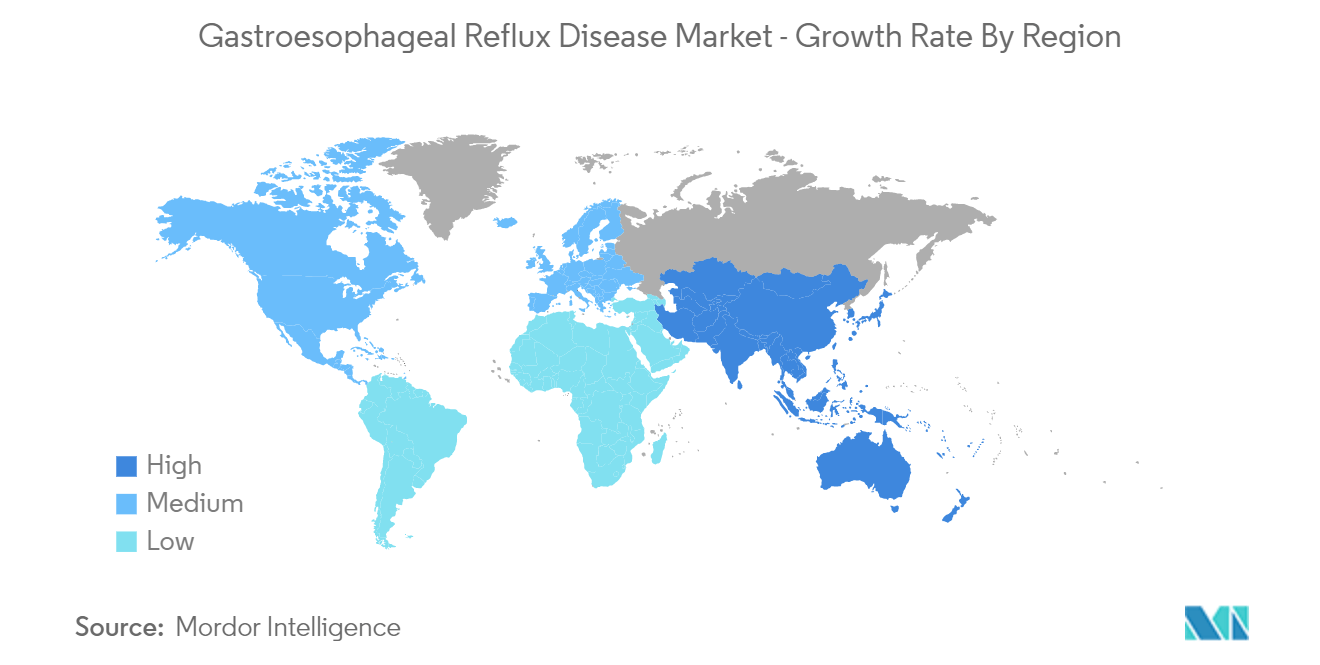Gastroesophageal Reflux Disease (GERD) Market Analysis
The Gastroesophageal Reflux Disease Market is expected to register a CAGR of 4.3% during the forecast period.
The COVID-19 pandemic impacted the market owing to supply chain disruptions due to lockdown restrictions in its initial phases. Also, the eating habits of people worldwide were affected due to the lockdown and isolation and people had started overeating which has resulted in high cases of gastroesophageal reflux diseases (GERD). Also, research studies indicated that COVID-19 severely impacted people with GERD. For instance, an article published in Human Molecular Genetics Journal in February 2022 stated that symptoms related to GERD were observed to be linked with a high risk for COVID-19. Therefore, the COVID-19 has led to an increase in demand for GERD medications during pandemic. Hence, the market witnessed a significant growth during the pandemic period.
Factors such as the rising prevalence of gastrointestinal reflux diseases, changing lifestyles, and increasing awareness about GERD are expected to fuel the market growth during the analysis period.
According to an article updated in July 2022 by the National Library of Medicine, GERD is one of the most prevalent chronic gastrointestinal disorders which affects about 20% of individuals in western culture and is defined by the regurgitation of gastric contents into the esophagus. Thus, this common condition among the target population is expected to increase awareness about the disease leading to diagnosis and treatment for the same. Thereby, it is expected to drive market growth over the forecast period.
Additionally, according to an article updated by the National Center for Biotechnology Information (NCBI) in May 2022, tobacco smoking is considered an etiological factor of reflux esophagitis or acid reflux and it is considered a major risk factor for acid reflux over the age of 50. Also, as per the article published in November 2021 by NCBI, the recent epidemiological studies stated that there is increasing GERD prevalence worldwide and the estimated prevalence of GERD ranged from 15% to 25%, while Saudi Arabia had GERD prevalence between 15% - 45.4%, Western Asia with 10%-20%, the Middle East with 8.7%-33.1%, and Eastern Asia reported less than 10% prevalence during the study. The high prevalence of the tobacco smoking and GERD is projected to boost the demand for the availability of drugs and diagnoses for the target population which is further predicted to contribute to market growth.
Furthermore, the development activities by the market players in the form of product launches, mergers, acquisitions, and investments are also expected to enhance the market growth. For instance, in October 2021, Medical City Frisco opened a new heartburn and reflux center making it the only one of its kind in Collin and Dallas counties. The Heartburn & Reflux Center offers minimally invasive robotic and laparoscopic treatment options for gastroesophageal reflux disease (GERD) and oesophageal disorders including transoral incisionless fundoplication (TIF). Such advancements are expected to drive the market to grow in the future.
Therefore, owing to the above-mentioned factors the market studied is expected to grow over the forecast period. However, the expiration of patents for blockbuster drugs and frequent product recalls are the factors are anticipated to restrain the market growth over the forecast period.
Gastroesophageal Reflux Disease (GERD) Market Trends
H2 Receptor Blockers Segment is Expected to Witness Growth Over the Forecast Period
H2-receptor blockers also known as H2-receptor antagonists are used to treat duodenal ulcers and prevent their return. A few examples of available H2-receptor blockers are H2 antagonists including Tagamet (cimetidine), Axid (nizatidine), and Pepcid (famotidine). They are also used to treat disorders like Zollinger-Ellison disease, in which the stomach generates too much acid and gastric ulcers. Thus, the use of such drugs is prescribed by physicians for gastroesophageal reflux disease (GERD)-related diseases.
When choosing drugs for common disorders (such as heartburn, and acid reflux) patients generally go for the cost-effective generic ones. These H2 receptor blockers are economical which is a major factor driving the segment growth. For instance, the article published by SingleCare in April 2022 reported that H2 antagonists are commonly used for heartburn and are relatively cost-effective, especially when patients choose generic versions for treatment. Thus, such cost-effectiveness of the drugs is anticipated to drive the segment growth over the forecast period.
Additionally, product approvals and launch are the primary factors that is contributing to the growth of the market. For instance, in April 2021, Sanofi's Consumer Healthcare launched a new over-the-counter (OTC) medication Zantac 360°. The medication labeling denotes a new formula with the active ingredient of famotidine, a different histamine-2 (H2) blocker. Famotidine, also known under the trade name Pepcid and Pepcid AC is currently available in both brand-name and generic formulations. Thus, such developments are anticipated to boost segment growth over the forecast period.
Therefore, owing to the factors mentioned above such as the advantage of H2 antagonist, high availability of such drugs, and rising launches, the segment is anticipated to witness growth over the analysis period.
North America is Expected to Hold the Largest Market Share over the Forecast Period
North America is anticipated to witness growth over the forecast period due to the factors such as an increase in healthcare expenditure, increasing R&D, and the rising prevalence of GERD. Additionally, the rising geriatric population across the United States is the primary driver for the growth of the United States GERD market.
GERD is a common condition that affects many people globally, while the prevalence is higher in western countries, especially in the United States. An article on Nissen Fundoplication published in the National Library of Medicine in July 2022 mentioned that GERD has the highest prevalence in the United States, ranging from 18.1% to 27.8% of individuals. Such a high burden of disease in the country is anticipated to create growth opportunities for advanced and effective drugs in the nation, thereby, expanding the market growth.
Furthermore, the market players are currently focused on the development of advanced therapeutics for GERD. For instance, in May 2022, Phathom Pharmaceuticals, Inc., a biopharmaceutical company focused on developing and commercializing novel treatments for gastrointestinal diseases received Food and Drug Administration (FDA) acceptance for review of the company's New Drug Application (NDA) for vonoprazan as a treatment for adults for the healing of all grades of erosive esophagitis (EE) and relief of heartburn and maintenance of healing of all grades of EE and relief of heartburn.
In addition, in January 2022, the generic formulation of Dexilant has released as Dexlansoprazole Delayed Release 30mg and 60mg capsules, manufactured by the company 'TWI Pharmaceuticals USA'. Dexlansoprazole is a proton pump inhibitor used to treat heartburn caused by GERD and to heal erosive esophagitis. Such developments in the country are major driving factors of the market studied in the region.
Therefore, owing to the factors mentioned above, the market studied is anticipated to witness growth in the region.
Gastroesophageal Reflux Disease (GERD) Industry Overview
The gastroesophageal reflux disease market is fragmented in nature owing to the presence of several market players. The market players are engaged in strategic initiatives such as mergers, acquisitions, product approvals, and launches to expand their presence. Some of the market players are Pfizer, Inc., Johnson & Johnson, SRS Life Sciences, Takeda Pharmaceutical Co., Ltd., and Haleon Group of Companies.
Gastroesophageal Reflux Disease (GERD) Market Leaders
-
Pfizer, Inc.
-
Johnson & Johnson
-
SRS Life Sciences
-
Takeda Pharmaceutical Co., Ltd.
-
Haleon Group of Companies
- *Disclaimer: Major Players sorted in no particular order
Gastroesophageal Reflux Disease (GERD) Market News
- In June 2022, Glenmark Pharmaceuticals Ltd acquired the approved generic versions of certain over-the-counter drugs from Wockhardt Ltd in the United States. The acquisition by the company's fully owned subsidiary Glenmark Pharmaceuticals Inc, USA includes the approved abbreviated new drug applications (ANDAs) for famotidine tablets (10 mg and 20 mg) used to treat and prevent ulcers in the stomach and intestine, including indigestion, heartburn, and acid reflux treatment drug Lansoprazole delayed-release capsules USP, 15 mg, among other drugs.
- In June 2022, Famotidine tablets developed by Zydus Lifesciences received FDA approval for the marketing of Famotidine in the strengths of 20mg and 40mg. Famotidine is a histamine H2 receptor blocker and works by reducing the amount of acid in the stomach. Also, the drug is used to prevent and treat heartburn and other symptoms caused by acid indigestion.
Gastroesophageal Reflux Disease (GERD) Industry Segmentation
As per the scope of this report, gastroesophageal reflux disease (GERD) is a disorder in which the lower oesophageal sphincter is affected and causes the backflow of contents from the stomach to the esophagus. The major causes of gastroesophageal reflux disease include obesity, smoking, and sedentary lifestyle habits. The Gastroesophageal Reflux Disease Market is Segmented by Diagnosis (Upper Endoscopy, Ambulatory Acid (pH) Probe Test, Esophageal Manometry, and Others), Drug Type (Proton Pump Inhibitors (PPIs), H2 Receptor Blockers, and Others), and Geography (North America, Europe, Asia-Pacific, Middle East and Africa, and South America). The market report also covers the estimated market sizes and trends for 17 different countries across major regions, globally. The report offers the value (in USD million) for the above segments.
| By Diagnosis | Upper Endoscopy | ||
| Ambulatory Acid (pH) Probe Test | |||
| Esophageal Manometry | |||
| Others | |||
| By Drug Type | Proton Pump Inhibitors (PPIs) | ||
| H2 Receptor Blockers | |||
| Others | |||
| Geography | North America | United States | |
| Canada | |||
| Mexico | |||
| Europe | Germany | ||
| United Kingdom | |||
| France | |||
| Italy | |||
| Spain | |||
| Rest of Europe | |||
| Asia Pacific | China | ||
| Japan | |||
| India | |||
| Australia | |||
| South Korea | |||
| Rest of Asia-Pacific | |||
| Middle East and Africa | GCC | ||
| South Africa | |||
| Rest of Middle East and Africa | |||
| South America | Brazil | ||
| Argentina | |||
| Rest of South America | |||
Gastroesophageal Reflux Disease (GERD) Market Research FAQs
What is the current Global Gastroesophageal Reflux Disease Market size?
The Global Gastroesophageal Reflux Disease Market is projected to register a CAGR of 4.3% during the forecast period (2025-2030)
Who are the key players in Global Gastroesophageal Reflux Disease Market?
Pfizer, Inc., Johnson & Johnson, SRS Life Sciences, Takeda Pharmaceutical Co., Ltd. and Haleon Group of Companies are the major companies operating in the Global Gastroesophageal Reflux Disease Market.
Which is the fastest growing region in Global Gastroesophageal Reflux Disease Market?
Asia Pacific is estimated to grow at the highest CAGR over the forecast period (2025-2030).
Which region has the biggest share in Global Gastroesophageal Reflux Disease Market?
In 2025, the North America accounts for the largest market share in Global Gastroesophageal Reflux Disease Market.
What years does this Global Gastroesophageal Reflux Disease Market cover?
The report covers the Global Gastroesophageal Reflux Disease Market historical market size for years: 2019, 2020, 2021, 2022, 2023 and 2024. The report also forecasts the Global Gastroesophageal Reflux Disease Market size for years: 2025, 2026, 2027, 2028, 2029 and 2030.
Our Best Selling Reports
Gastroesophageal Reflux Disease Industry Report
Statistics for the 2025 Gastroesophageal Reflux Disease market share, size and revenue growth rate, created by Mordor Intelligence™ Industry Reports. Gastroesophageal Reflux Disease analysis includes a market forecast outlook for 2025 to 2030 and historical overview. Get a sample of this industry analysis as a free report PDF download.







